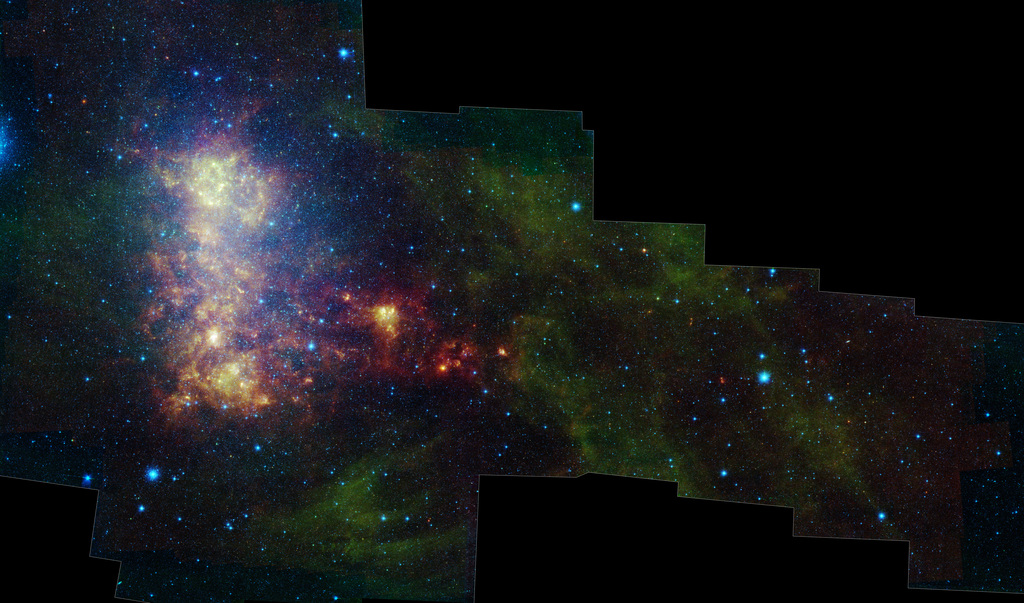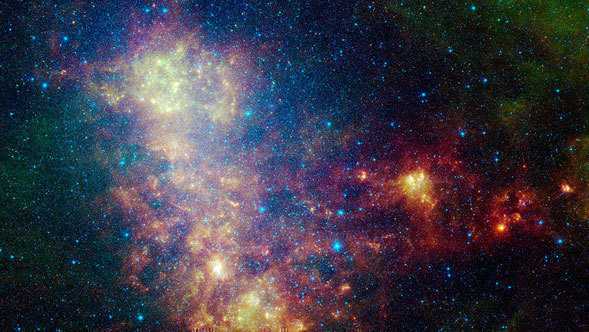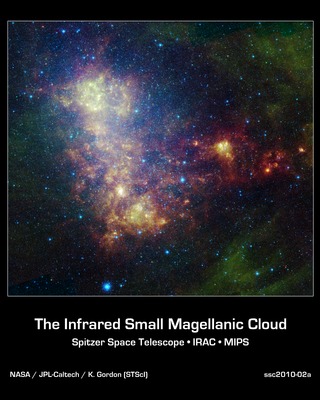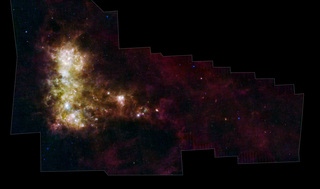
Credit: NASA/JPL-Caltech/K. Gordon (STScI)
Observation • January 5th, 2010 • ssc2010-02b
ssc2010-02b
The infrared portrait of the Small Magellanic Cloud, taken by NASA's Spitzer Space Telescope, reveals the stars and dust in this galaxy as never seen before. The Small Magellanic Cloud is a nearby satellite galaxy to our Milky Way galaxy, approximately 200,000 light-years away.
The image shows the main body of the Small Magellanic Cloud, which is comprised of the "bar" and "wing" on the left and the "tail" extending to the right. The bar contains both old stars (in blue) and young stars lighting up their natal dust (green/red). The wing mainly contains young stars. The tail contains only gas, dust and newly formed stars. Spitzer data has confirmed that the tail region was recently torn off the main body of the galaxy. Two of the tail clusters, which are still embedded in their birth clouds, can be seen as red dots.
In addition, the image contains a galactic globular cluster in the lower left (blue cluster of stars) and emission from dust in our own galaxy (green in the upper right and lower right corners).
The data in this image are being used by astronomers to study the lifecycle of dust in the entire galaxy: from the formation in stellar atmospheres, to the reservoir containing the present day interstellar medium, and the dust consumed in forming new stars. The dust being formed in old, evolved stars (blue stars with a red tinge) is measured using mid-infrared wavelengths. The present day interstellar dust is weighed by measuring the intensity and color of emission at longer infrared wavelengths. The rate at which the raw material is being consumed is determined by studying ionized gas regions and the younger stars (yellow/red extended regions). The Small Magellanic Cloud, and its companion galaxy the Large Magellanic Cloud, are the two galaxies where this type of study is possible, and the research could not be done without Spitzer.
This image was captured by Spitzer's infrared array camera and multiband imaging photometer (blue is 3.6-micron light; green is 8.0 microns; and red is combination of 24-, 70- and 160-micron light). The blue color mainly traces old stars. The green color traces emission from organic dust grains (mainly polycyclic aromatic hydrocarbons). The red traces emission from larger, cooler dust grains.
The image was taken as part of the Spitzer Legacy program known as SAGE-SMC: Surveying the Agents of Galaxy Evolution in the Tidally-Stripped, Low Metallicity Small Magellanic Cloud.
About the Object
- Name
- SMC • Small Magellanic Cloud • NGC 292
- Type
- Galaxy > Type > Barred
- Galaxy > Size > Dwarf
- Nebula > Type > Star Formation
- Distance
- 197,000 Light Years
Color Mapping
| Band | Wavelength | Telescope |
| Infrared | 3.6 µm | Spitzer IRAC |
| Infrared | 4.5 µm | Spitzer IRAC |
| Infrared | 8.0 µm | Spitzer IRAC |
| Infrared | 24.0 µm | Spitzer MIPS |
| Infrared | 70.0 µm | Spitzer MIPS |
| Infrared | 160.0 µm | Spitzer MIPS |
Astrometrics
- Position (J2000)
- RA =1h 27m 11.0s
- Dec = -73° 57' 31.8"
- Field of View
- 9.3 x 5.5 degrees
- Orientation
- North is 148.4° left of vertical







